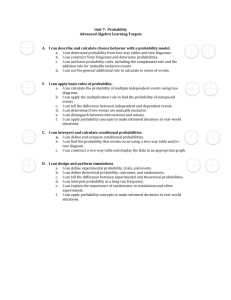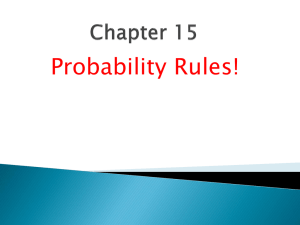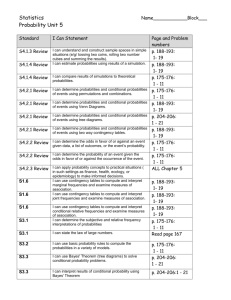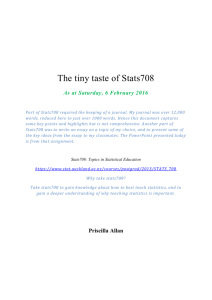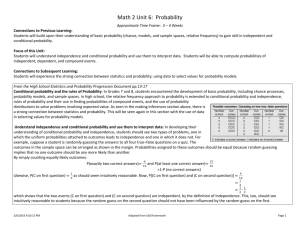01 Common Core Geometry Unit 5 Framework
advertisement
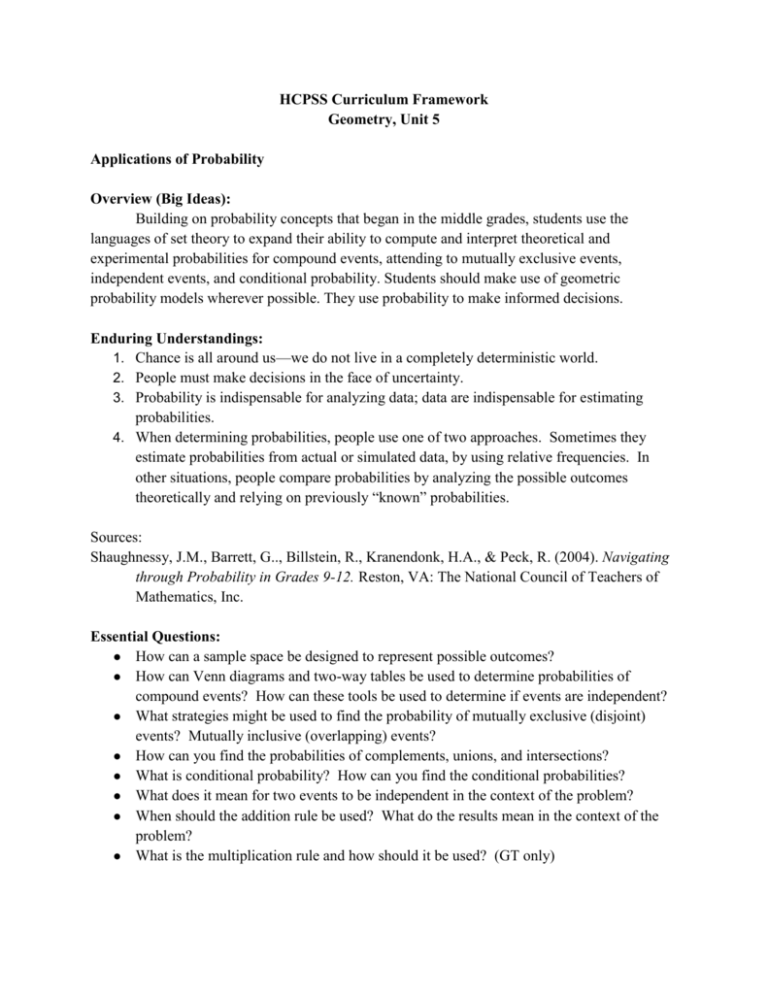
HCPSS Curriculum Framework Geometry, Unit 5 Applications of Probability Overview (Big Ideas): Building on probability concepts that began in the middle grades, students use the languages of set theory to expand their ability to compute and interpret theoretical and experimental probabilities for compound events, attending to mutually exclusive events, independent events, and conditional probability. Students should make use of geometric probability models wherever possible. They use probability to make informed decisions. Enduring Understandings: 1. Chance is all around us—we do not live in a completely deterministic world. 2. People must make decisions in the face of uncertainty. 3. Probability is indispensable for analyzing data; data are indispensable for estimating probabilities. 4. When determining probabilities, people use one of two approaches. Sometimes they estimate probabilities from actual or simulated data, by using relative frequencies. In other situations, people compare probabilities by analyzing the possible outcomes theoretically and relying on previously “known” probabilities. Sources: Shaughnessy, J.M., Barrett, G.., Billstein, R., Kranendonk, H.A., & Peck, R. (2004). Navigating through Probability in Grades 9-12. Reston, VA: The National Council of Teachers of Mathematics, Inc. Essential Questions: ● How can a sample space be designed to represent possible outcomes? ● How can Venn diagrams and two-way tables be used to determine probabilities of compound events? How can these tools be used to determine if events are independent? ● What strategies might be used to find the probability of mutually exclusive (disjoint) events? Mutually inclusive (overlapping) events? ● How can you find the probabilities of complements, unions, and intersections? ● What is conditional probability? How can you find the conditional probabilities? ● What does it mean for two events to be independent in the context of the problem? ● When should the addition rule be used? What do the results mean in the context of the problem? ● What is the multiplication rule and how should it be used? (GT only) ● How can you determine if a situation is best modeled using permutations or combinations? How can permutations and combinations be used to calculate probabilities? (GT only) ● How can probabilities be used to analyze and make fair decisions? (GT only) Common Misconceptions: ● Students sometimes have difficulty determining whether or not a probability is a conditional probability. ● Students need exposure to multiple representations. Otherwise they get the algorithms confused. Curriculum Standards: Understand independence and conditional probability and use them to interpret data. S.CP.A.1 Describe events as subsets of a sample space (the set of outcomes) using characteristics (or categories) of the outcomes, or as unions, intersections, or complements of other events (“or”, “and”, “not”). S.CP.A.2 Understand that two events A and B are independent if the probability of A and B occurring together is the product of their probabilities, and use this characterization to determine if they are independent. S.CP.A.3 Understand the conditional probability of A given B as P(A and B)/P(B), and interpret independence of A and B as saying that the conditional probability of A given B is the same as the probability of A, and the conditional probability of B given A is the same as the probability of B. S.CP.A.4 Construct and interpret two-way frequency tables of data when two categories are associated with each object being classified. Use the two-way table as a sample space to decide if events are independent and to approximate conditional probabilities. S.CP.A.5 Recognize and explain the concepts of conditional probability and independence in everyday language and everyday situations. Use the rules of probability to compute probabilities of compound events in a uniform probability model. S.CP.B.6 Find the conditional probability of A given B as the fraction of B’s outcomes that also belong to A, and interpret the answer in terms of the model. S.CP.B.7 Apply the Addition Rule, P(A or B) = P(A) + P(B) – P(A and B), and interpret the answer in terms of the model. S.CP.B.8 (+) Apply the general Multiplication Rule in a uniform probability model, P(A and B) = P(A)P(B|A) = P(B)P(A|B), and interpret the answer in terms of the model. S.CP.B.9 (+) Use permutations and combinations to compute probabilities of compound events and solve problems. Use probability to evaluate outcomes of decisions. S.MD.B.6 (+) Use probabilities to make fair decisions (e.g., drawing by lots, using a random number generator). S.MD.B.7 (+) Analyze decisions and strategies using probability concepts (e.g., product testing, medical testing, pulled a hockey goalie at the end of a game).
